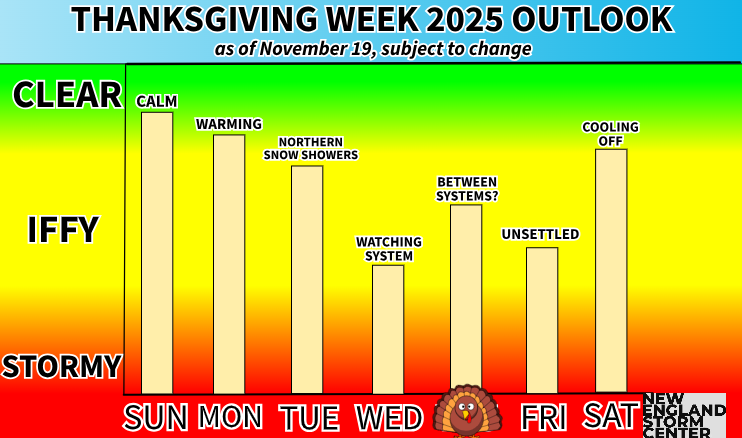Heavy Rain, Snow and High Winds Incoming to New England: Impacts, Timing
- Tim Dennis
- Jan 9, 2024
- 6 min read
New England's next storm is currently across the country's midsection and will be quickly moving northeast into the Great Lakes today. This storm, unlike the weekend storm, will be a multi-hazard event with rain, snow, wind and some coastal flooding. Also unlike the weekend storm, this will be a quick-hitter.

The storm will initially start with a burst of snow or a wintry mix, however, a surge of mild air from the south will work through New England, gradually changing the wintry mix to plain rain from south to north. Naturally, the further north (and east) you are in New England, the longer the storm will be snow, leading to more accumulation. For southern and central areas, heavy rain combined with fresh snow melt will lead to flooding concerns. There will also be two distinct areas of potentially damaging winds.

ALERTS
TIMING
Precipitation will enter into southwest Connecticut Tuesday afternoon and spread northeast throughout Tuesday evening. As stated in the introduction, most areas will see a quick burst of snow before a changeover to rain as the mild air surges northward. Some accumulations will be possible in southern New England, mainly in the higher terrain. This will be washed away quickly.
Expected weather Tuesday evening:

By the early morning hours of Tuesday, all of southern New England should be seeing plain rain. Southern New Hampshire and Vermont will also likely have made the transition at this time. Further north, heavy snow will likely still be ongoing. The snowfall will also make its way into northern and eastern Maine at this time.
When we said this would be a quick-hitter, we meant it. Southern New England will begin winding the storm down by sunrise Wednesday. Vermont and New Hampshire won't be long after that. Maine, being the furthest east, will naturally remain in the storm longer than the rest, though it will start later. Despite the quick wind down, winds will remain gusty after the storm exits.
Expected weather overnight Tuesday to Wednesday (1st image) and Wednesday around sunrise (2nd image):
By Wednesday afternoon, scattered showers will likely be persisting as the region will remain under cyclonic flow. The main storm system will have exited well to New England's north. Some clearing may be able to happen Wednesday afternoon across southern New England.
Expected weather Wednesday afternoon:

RAIN
The biggest concern with this storm system will be the pounding rain combined with recent snowmelt. The further south in New England you are, the higher the concern for potential flooding issues as more rain is expected. Further north, this will be more of a wintry event. The amount of moisture in the atmosphere will be more representative of summer rather than winter as a southeast flow surges into New England.
The one piece of the storm that will help New England is the fact that the storm is moving very quickly, so while the rainfall will be very heavy, it won't last for hours and hours on end. Despite this, rainfall rates will be very heavy. When the storm finishes, a widespread 1-3 inches of rain will likely have fallen across southern and central New England with some amounts possibly nearing 4 inches in Connecticut. Lesser rain will be seen north thanks to more snowfall.

With heavy rainfall rates comes the possibility of flash flooding and street flooding. This much rain will also combine with snowmelt after as much as a foot and half fell in parts of New England. Continued snowmelt through Wednesday will also likely lead to some river flooding.
The biggest concern for flooding lies where the snow has much more liquid within it in southern New England. These areas may see up to 5 inches of water enter the watersheds, leading to river flooding. The threat for river flooding goes down the further north in New England you go. The Pawtuxet River at Cranston, RI, which has been an issue during other flooding events recently, currently has a 30% chance to reach major flood stage.
Across central and southern New England, the snow is drier. These areas also saw over a foot of snow during the weekend, so some of the snowpack is expected to survive. This will be beneficial in limiting flooding somewhat. There are still concerns for street and poor drainage flooding due to clogged drains in these areas.

SNOW
As stated in the introduction, the storm will begin as a burst of snow before changing over to rain from south to north. Generally, the further north and higher in elevation you are, the longer the change over will take, leading to more snow. Areas that stay snow for most of Tuesday night will likely see upwards of 10"+ inches of snow. Some of this will be washed away once the change to rain occurs.
There could be two areas with a sharp cutoff in snow totals: The Connecticut River Valley of northern New England and heading toward the Maine coastline. You likely won't have to go too far inland from the Maine coast to get into heavier snowfall amounts. This can be seen in the expansion of winter storm warnings to the Maine coastal counties, but not to the immediate coast.

The snow will be heavy and wet in nature. This is the kind of snow that will stick to everything. With six or more inches of this snow, it could lead to broken tree branches, especially when factoring the higher wind gusts expected. Snow is expected to switch over to rain across the entire region, but areas that stay in the snow well into Tuesday night could see snowfall rates of 1 inch or more an hour.
WIND
Another big issue with this storm will be high, possibly damaging winds. There will likely be two areas in New England that see the strongest winds: the higher elevations of western New England (Green mountains and Berkshires) and along the coast. At the coast, a strong low-level jet (winds at about 2,500 feet above sea level) will have the chance to create gusts of 60-70mph, with the strongest across downeast Maine and Cape Cod. The big question, as always, with this setup will be just how much of that strong wind aloft can make it to the ground.
Further inland, a strong temperature inversion will make it difficult for the stronger winds to make it to the ground. A temperature inversion can act as a barrier, stopping winds from getting to the surface. This inversion is thanks to the snowpack keeping the ground level cooler than the milder air surging from the south.

The exception to this will be over the Green mountains of Vermont. A strong pressure gradient between the area of low pressure to the west and an area of high pressure to the east will be enough to create winds of up to 50mph in these areas. The storm will then have the potential to create a downslope wind event. This could boost wind gusts in the western Green Mountains and possibly northern New Hampshire to the 60-65mph range.
With all of that said, the storm will be able to produce winds of at least 40mph across nearly all of New England. Power outages will be a concern across coastal areas and Vermont plus the White mountains.

COASTAL FLOODING
There is a chance for coastal flooding with a southeast flow causing a surge of 2-4 feet, with Narragansett Bay looking at the highest surge. The big question is if this surge will be timed with high tide. With the storm moving so fast, it will take precise timing for the maximum surge to occur during the Wednesday morning high tide. Right now, it appears this surge will occur before high tide from southern Maine through New England's south coast. This will help limit coastal flooding to minor impacts in these areas.
From Maine's midcoast through downeast, there is a better chance of max surge happening during high tide. These areas will have the best chance to see moderate coastal flooding. A coastal flood watch is in effect for the entire New England coast as a difference of just an hour will have a major impact on whether or not higher impacts will be felt across central and southern New England.
Wind direction and potential gusts around the Wednesday morning high tide:

THE NEXT STORM
Another storm similar to this one will likely move through Friday night to Saturday. This could be another multi-hazard storm with snow, rain and wind. That storm is looking to take a similar track as this incoming one. Overall, this storm looks to be an even faster mover with overall lower precipitation than this one. More alerts may need to be issued for this upcoming storm.











Comments